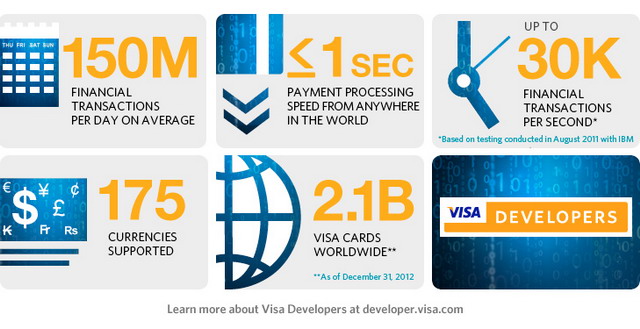To learn more about Visa technology, check out the Visa Developer Program.
Introduction
Credit cards have been around since the late 1950’s, when
the concept of revolving credit offered people a revolutionary way to pay.
Then, in the mid-1970’s the success of these early cards went international,
leading to the birth of Visa and its global processing backbone, VisaNet. By
the 1980’s, Visa was truly "everywhere you want to be,"
allowing consumers to use their Visa cards for everyday transactions.
In today’s connected world with billions of cards in
circulation and tens of millions of merchants accepting Visa, whether online, on
mobile, at the point of sale, through ATMs, etc. -- Visa has evolved to meet
the changing ways that consumers shop and pay for their goods and services.
As a result, Visa has become one of the most formidable
names in interconnected financial systems. The technology needed to support those
millions of merchants all over the world has to be extremely robust, reliable,
and above all, secure. When you swipe, scan, or enter your Visa account number
online, your payment immediately enters the Visa network, called VisaNet. VisaNet
is the largest retail electronic payments system in the world, serving a wide
range of customers from giant banks to mom-and-pop shops. Think about the application
systems you work on every day, and let’s compare them to the mammoth scale of VisaNet.
Consider the following facts:

The speed, reliability and scale of VisaNet is truly
impressive. As a software developer who has run a number of large websites
with 24/7 reliability expected, these numbers blow me away. In the past, my
teams of engineers would spend months working to raise performance above more
than a few hundred transactions a second. We
didn’t have many servers or high powered databases on a lightning-fast network,
and had to squeeze every ounce of performance from our puny infrastructure. VisaNet has overcome all of these and other
challenges in it’s over 40 years of operations.
And what about the security of those transactions? A
network of electronic payment services is a ripe target for a team of hackers
or terrorists. Check out this video from
Australian TV for a rare walkthrough of one of the fortress-like Visa
operations centers.
Visa’s Operations
Control East is hidden somewhere on the
East Coast of the United States. They won’t tell us exactly where, but they
have redundant EVERYTHING in this data center: power, network, cooling, and
water.

Visa Operations Control East
Do you remember the movie "WarGames”? At the end of that
movie, there is a dramatic scene in a military operations center with giant
screens, and they play a giant game of tic-tac-toe against the rogue computer
WOPR.
Visa has this operations center! Every transaction from around
the world is monitored in real-time at Visa’s data centers. If your card is
used in a manner that appears dubious, alerts are raised to the analysts in this
room and they can take the steps to stop fraud and block your card from being misused
again.
How can developers use Visa?
Payment service requirements are as diverse as developers
themselves. You may be part of an in-house team that needs to integrate new
services into your financial institution’s product portfolio. Or you may work
for a payment hardware or software provider that wants to optimize the point of
sale experience. Or maybe you’re creating an NFC-enabled wallet app for a
mobile handset maker or carrier. Many developers just need to add a simple and
reliable payment component to their eCommerce site, or mobile app, or game.
The Visa Developers program has the tools, resources, and
support to help you tap the power of VisaNet and Visa’s vast array of products
and services. If you’re new to the world of payments, they can help you learn more
about it; in fact, you can experiment with some of Visa’s APIs and SDKs
directly on the Visa
Developers website. Although some products are for partners only, others
such as V.me and Visa Personal Payments, offer free access to their sandbox, so
you can build and test your ideas in a ‘real’ system. The Visa Developers site
is also a good entry point for access to Visa’s affiliates, like Authorize.Net
for small to medium business solutions or PlaySpan for games and apps.
For decades, I’ve been trusting Visa with all of my personal
transactions. Now that I know they have a powerhouse technology platform
sitting behind their payment services, as a developer I want to learn more
about what that means for my professional projects and clients. Join me in
signing up for their
developer program and get started with services that you know you can
trust.
